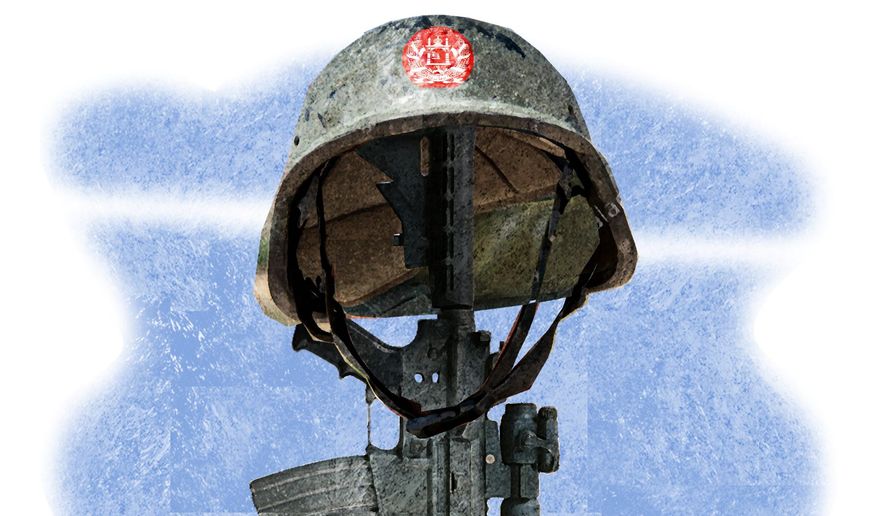OPINION:
There is no honor in kicking someone when they are down.
But in August, as the Afghan people watched the Taliban invade their capital city with machine guns and saw their hopes of living with dignity and freedom fade, President Joe Biden hit them where it hurt most—their honor.
In his first address on the developing crisis, Mr. Biden inaccurately overestimated the strength of Afghanistan as having a “military force of some 300,000 strong”. He accused the Afghan forces of being “not willing to fight for themselves.”
This contradicts Gen. Kenneth F. MacKenzie’s Wednesday House Armed Services Committee testimony in which he affirmed that it was Afghanistan’s forces that “provided most of the physical security at Bagram [Airfield],” and asserted that without their assistance, the U.S. would have needed more troops to protect it.
Mr. Biden may have confused the Afghan National Defense and Security Forces (ANDSF), which encompasses all military, police, and security forces’ personnel’ with the number of actual combat troops that fight on the battlefield, a critical informational point in this debate.
In actuality, the evidence suggests Afghanistan’s forces fought bravely with fatal consequences.
A 2019 DoD report indicated that while the ANDSF had 352,000 personnel, the Afghan National Army (ANA) had only 180,869 personnel (not combat troops), a number that was diminishing at a significant rate even then.
According to a report published by Brown University’s Watson Institute of International & Public Affairs, as many as 78,314 Afghan soldiers and police have been killed since 2001, and an estimated 51,000 Afghan civilians have also been killed.
This suggests Afghans in police or military service suffered a casualty rate at more than 32 times the 2,442 combat deaths of U.S. troops.
Afghanistan’s troop numbers have also been inflated for several years, a problem for Afghan soldiers brave enough to show up since they were often outgunned.
In 2016, Britain’s Guardian newspaper reported, “The problem is many [ANA] troops don’t exist. Across Afghanistan, lists of troops and police officers are filled with fake names, or the names of men killed in fighting, but not officially declared dead.” One provincial council found that “approximately 40% of enlisted troops did not exist.”
In 2017, the Wall Street Journal reported the U.S. military removed more than 30,000 names from its records and removed 42,000 in 2019 because of inflated misreporting.
In 2019, the U.S. Special Inspector General for Afghan Reconstruction (SIGAR) issued a 270-page report indicating the ANDSF had many ‘ghost soldiers,’ a term signifying soldier names that appear on military rolls but are not actually in service because of combat deaths and corruption.
In only a three-month quarter from March-May 2019, there were 6,445 enemy-initiated attacks (EIAs). In the report, John Sopko, the head of SIGAR, commented, “The Afghan government cannot survive financially or militarily without continued external assistance….”
An earlier 2016 CBS report noted Afghanistan’s ‘ghost soldier’ problem was “particularly severe in the southern Helmand province, where the Taliban have seized vast tracts of territory in the 12 months since the U.S. and NATO formally ended their combat mission and switched to training and support.”
Even amidst U.S. forces scaling back, many Afghans fought to protect their country. After President Ashraf Ghani’s flight to UAE, Vice-President Amrullah Saleh announced a stronghold of pro-democracy Afghan fighters in the Panjshir valley who continued fighting.
Videos released on social media showed Saleh was joined by Afghan Defense Minister Gen. Bismillah Mohammadi and Ahmed Massoud, the son of the assassinated Northern Alliance leader of the same name. One ANA officer in hiding told the Hindustan Times he believed that with Mr. Massoud on their side, the ANA could defeat the Taliban.
“Believe me. Our army is strong. [The Taliban] are not that strong to overcome us by military force. It happened because the politicians sold us. They sold out the dignity and values… [of soldiers] who sacrificed their lives for our national flag and nation… Mr. Massoud has repeatedly said he will struggle against [the’ Taliban] as we are not going to accept their rule again… there is still hope. We will struggle.”
These stories signify courage, not cowardice, a sentiment captured in British MP Tom Tugendhat’s heartfelt speech to Parliament when he courageously criticized NATO’s abandonment of the Afghan people.
The Biden administration should consider that its own optics-driven, hurried withdrawal of U.S. troops armed the Taliban with confidence and swept the country with panic.
As Gen. Mark A. Milley testified last week, had the White House followed he and Gen. MacKenzie’s advice to keep a minimal presence of 2,500 soldiers in Afghanistan, it would have sent hope to the country.
“It has as much to do with the morale… of the Afghan security forces and demonstrating confidence in the government… they became dependent upon our presence…” he told the House Armed Services Committee.
Afghanistan’s forces fought bravely. They only needed a sign America would stand by them as we have in South Korea and Western Europe. To degrade those brave Afghan men and women who risked their lives is damaging to what remains of their country’s national spirit. President Biden owes the Afghan people and its forces an apology.
• Jeffrey Scott Shapiro is an attorney and journalist who served as a senior U.S. official from 2017-2021.




Please read our comment policy before commenting.